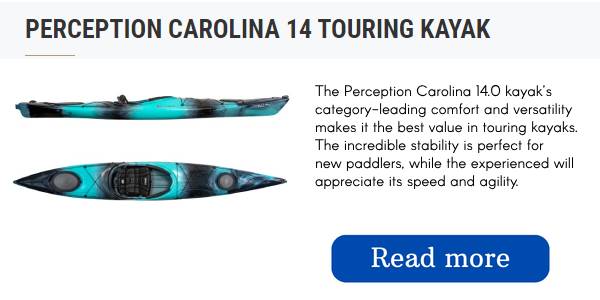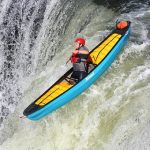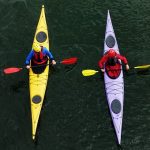To understand why a kayak rudder or skeg is such a brilliantly useful addition to your kayak, you first need to understand the physics (only the basics!) of how kayaks typically handle.
Kayaks are designed to sit on top of the water, with only the hull partially submerged.
So let’s dive in…
Kayak Handling Explained: Tracking and Steering
When you’re paddling forward and slicing through the water, the bow encounters minimal fluid resistance—also known as “drag”.
However, as the water slides along the hull of your kayak, the fluid resistance increases, and more lateral (side to side) pressure is exerted on the kayak. By the time the water reaches the stern (back of the kayak), there is high fluid resistance—ergo, more water pushing laterally against the kayak.
And that’s not all!
When the water slides past the bow, it envelops the bow and sort of “pins” it into place so it can track straight. However, when it slides off the stern, there is no “pinning”, so the back of the kayak tends to move around a lot more than the bow.
Add to this the current, waves, and winds hitting you from the side, and you’ve got a recipe for veering off track. The bow of your kayak stays straight, but the stern ends up moving around a lot more—what is known as “weathercocking”.
Compensating for Weathercocking
Most of the time, you end up compensating for weathercocking through your paddling stroke. If you notice your kayak is veering off to one side or the other, you typically adjust your stroke so you can turn back in the “right” direction and stay straight.
However, rudders and skegs are another VERY useful solution for counteracting weathercocking.
The blade of the rudder or skeg will slow down the movement of your stern, essentially stopping the waves, wind, and water current from pushing it off track. It will keep the stern of your kayak (mostly) aligned with the bow so you can slice straight through the water with minimal lateral movement.
Rudders can one-up the skeg’s fixed-blade design by twisting from side to side, allowing you to steer according to the wind, waves, and current. It’s an amazing addition that will drastically increase both tracking and handling.
Tracking vs. Handling: There is a Difference!
When I first started kayaking, I had no idea that these two were different terms. Thankfully, a buddy of mine explained them to me, and now I’m going to share them with you because understanding them will change the way you approach paddling.
Tracking refers to how straight the kayak moves. A kayak that “tracks” well will typically move in a very straight line, thanks to unique hull designs or the addition of a rudder or skeg.
Handling, also known as “steering”, refers to how maneuverable the kayak is, how efficiently it can make sharp turns. Think about it like the “turning radius” of your car—the better it handles, the more effectively it can turn.
Now, what you need to understand is that a kayak that tracks straight will typically be less maneuverable, while a kayak that steers very well and can make sharp turns often won’t track very straight.
This is because, in kayak design, these two elements (sort of) cancel each other out.
Defining Kayak Rudders vs. Kayak Skegs
I want to take a moment to look more closely at the parts of these two systems. I hope it helps you understand the small but important differences between them.
Parts of a Kayak Rudder System
A rudder system typically comes with five parts:
- The blade. This is a long, narrow fin-like blade that extends from the stern of your kayak into the water.
- The pedals. These are the “steering controls” that allow you to use your feet to twist the blade from side to side. (Note: Some rudder systems use hand-levels, but pedals are the most common steering control.)
- The cables. These are cables, typically made from stainless steel, that connect the pedals to the blade.
- The mount. This is the hardware that secures the rudder to the stern of your kayak.
- The lift lines. These are long loops (typically located near your kayak’s cockpit) that let you stow or deploy your rudder.
Connecting the rudder system can be a bit tricky. You’ve got to make sure your kayak is designed for or compatible with a rudder system (see more details below). But once it’s installed, steering is beautifully easy.
Press on the right-foot pedal to twist the rudder one way, and the left-foot pedal to twist it the other way.
Just like that, you’re steering your kayak where you want it to go because the blade extended into the water is directing the water that slides off the back of your stern in the “right” direction.
What is a Kayak Skeg?
A kayak skeg is basically a “fin” that is fixed to the underside of your kayak in the center of your hull, typically near the stern.
It functions the same as a rudder—cutting through the water that slides off the hull of your boat. But unlike a rudder, it doesn’t turn. This means that it’s less focused on maneuverability and its primary purpose is to improve tracking.
Some skegs are adjustable, allowing you to deploy part or all of the fin according to the water current. However, these tend to come built into the kayak. Any skeg you’re going to install yourself is likely to be a fixed, non-adjustable skeg. They’ll be less versatile, but still provide excellent tracking.
I will warn you that skegs can interfere with your handling. They’re designed to keep you tracking straight, and may slow down your ability to turn.
That’s why they’re typically used on kayaks that already handle really well, but struggle with tracking. Adding a skeg will ensure your responsive kayak travels in a straight line, and the addition won’t significantly impact your ability to steer and cut sharp turns.
Why Are Rudders And Skegs Needed?
In most cases, rudders and skegs might not be needed to aid in steering a kayak. If you are stable and everything is okay, then you will not have any use for either of them. However, some conditions might force you to deploy or use a rudder or a skeg.
Nature is unpredictable, and sometimes there might be strong winds or tides, and you might need to stabilize your kayak.
When faced with such circumstances, you might need the aid of either a skeg or a rudder to steer you in the right direction. If you are good at paddling, your kayak might still go straight, but to avoid the trouble, it is advisable to deploy either a skeg or a rudder.
They also help you to save a lot of energy that would have been otherwise used is trying so hard to steer your kayak properly.
Why Do Some Kayaks Have Rudders While Others Have Skegs?
Three main factors can determine whether a kayak should have a rudder, a skeg, or neither of the two. These main factors will contribute immensely to the kind of stability that a kayak requires hence the need for their consideration. They include:
1. The design of the hull
2. The intended use
3. The length of the kayak
Kayaks with skegs are primarily designed to perform well in dynamic or challenging environments. Due to the amount of rocker that they possess, the paddler has better control and can stabilize the kayak more efficiently and easily.
They are considerably easy to navigate due to the amount of rocker and the design of the hull. They are suitable for coastal environments with a lot of moving water.
Kayaks with rudders are considered by many to be the most efficient ones. They are usually slightly longer and have a lot of storage. From the design, they are built to be able to paddle in a straight line with ease.
The rocker is fairly less compared to that of a skeg kayak. Due to their length, a paddler might need a rudder to aid in steering the kayak. They are ideal for long-distance paddling. However, they might not be suitable for dynamic environments.
There also exist some kayaks that have no skeg or rudder. They are usually short compared to others. Since they are short, it is easy for a paddler to control them.
Is It Okay To Have Both A Skeg And A Rudder On The Same Kayak?
Yes, it is okay to have both the skeg and rudder; however, they perform almost the same functions. They are similar even in appearance. Nonetheless, there are some slight differences, the main one being the position.
Even though one might not need them simultaneously, they are still important for even the steadiest kayak might veer off course once in a while.
A rudder is used most of the time due to the nature of control that it brings along. It is important to be able to have control of your kayak more proficiently. A rudder is, however, prone to damages, and you might need a skeg in the process.
It is more straightforward since it does not need steering once deployed.
Both the rudder and the skeg are very important, but if you are not struggling to keep control of your kayak, then they should both be kept up. Having them is very important.
What Is The Difference Between A Rudder And A Skeg?
Rudder
A rudder is a long narrow fin-shaped blade that is found at the stern end of a kayak. They extend into the water. Rudders are operated by foot pedals that are found at the cockpit of a kayak.
When deployed, rudders are operated by moving them from side to side to steer the kayak in the desired direction. The blades determine the direction that you want your kayak to move towards.
Skeg
A skeg, just like a rudder, is a fin-shaped blade. The only difference with a rudder is the location. Skegs are located centrally on the keel of the kayak. Skegs have different models; some can be retracted and stored when not used and only deployed when there is a need.
Other designs are incorporated into the design of the keel. A movable or retractable skeg can be deployed either partly or fully and can only be moved up and down but not sideways like the case of rudders. This means that they cannot be steered.
Skegs and rudders are almost similar in terms of appearance and functions. The only difference is their location on the kayak.
What Are The Advantages And Disadvantages Of Skegs And Rudders?
Making the right decision on whether to settle for a skeg or a rudder depends on learning the main differences; advantages and disadvantages.
Just like any other item, they both have their pros and cons. These are discussed below:
Advantages Of Rudders
1. Rudders are fairly easy to operate compared to skegs. Beginners, therefore, may find them easy to use and understand.
2. Due to the side-to-side movement, a ruder can enact a huge change in direction. This may enable a paddler to change directions drastically as compared to a skeg.
3. Due to its reliability, a rudder can compensate for a lack of skills from a paddler as it can make the kayak move in a straight direction, especially in dynamic environments.
4. Since a rudder cannot be retracted and stored, kayaks with rudders have a lot of storage space left in them.
In case of a breakdown, parts of a rudder are easy to repair compared to a skeg.
Disadvantages Of Rudders
1. The movement of the rudders from side to side when steering can cause a significant drag, therefore slowing down the kayak
2. Rudders can cause a sense of overdependency on the part of the paddler, hindering them from gaining more paddling skills.
3. Rudders involve a lot of moving parts, and this may lead to a constant breakdown of the parts, which in turn means constant repairs.
4. After a while, the pedals might not be firm enough, making it hard to steer.




